After an unsuccessful go with Alternanthera reineckii (didn’t thrive) and another with Alternanthera reineckii ‘Rosanervig’ (eaten by Amano shrimp), I’m giving it try with Alternanthera reineckii ‘Mini’. This AR ‘Mini’ came from Pro Shrimp, and was grown by Tropica. I have had mixed results purchasing aquatic plant tissue culture cups before, but this AR ‘Mini’ cup is one of the best I’ve ever seen. The plants arrived in superb condition, with a huge number of goodly sized, mostly correctly structured plantlets. Sometimes tissue culture plants can have a confused growth structure where it seems the plant doesn’t really have a good sense of top (leaves) from bottom (roots) and in some quarters tissue culture plants have a reputation for being more fragile than their potted counterparts, but I’m really optimistic about this latest batch.
In terms of growth in a new environment, tissue culture plants are in some ways well equipped to get a running start, since they don’t come with a large amount of emersed-growth-adapted leaves that would need to die off and get replaced by the new submersed-growth forms. To make some room for the AR ‘Mini’ with good lighting, I cleared back some of the vallis; the vallis is so prolific that it needs a periodic clear out in any event. Now I’m just hoping that that amanos don’t like eating the ‘Mini’ as much as they seemed to enjoy the Rosanervig…
With so many high-quality plantlets there was lots of AR ‘Mini’ left to be able to give it a try in the low-tech (non CO2-injected) environment of the Shrimphaus. Tropica says that, “high light intensity and addition of CO2 improves the plant’s growth and overall appearance“, but this will be true for most aquatic plants and doesn’t necessarily mean the AR ‘Mini’ can’t be a success without injected CO2. In any event, this will be a good opportunity to compare/constrast the plant in two different environments from the same starting point.
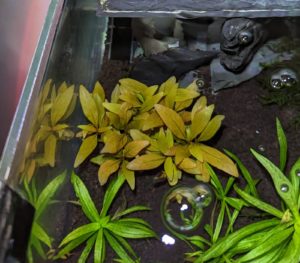
Alternanthera reineckii ‘Mini’ time lapse growth update
The ‘Mini’ was planted at the same time in both the Fireplace Aquarium and the Shrimphaus. Fireplace Aquarium has injected CO2 gas and is heated to 25C. Fireplace Aquarium also has Alternanthera-eating amano shrimp! Shrimphaus has no CO2 injection and is at ambient temperature around 20C. I have been dosing Shrimphaus periodically with EasyCarbo to make sure the black beard algae doesn’t come back. I stopped liquid carbon dosing the Fireplace Aquarium a long time ago. Shrimphaus has bloody mary shrimp (Neocaridina – cherry shrimp) and their taste for Alternanthera species is unknown…
5 weeks after planting AR ‘Mini’
You’d expect the ‘Mini’ to do much better in the high-tech tank, but that doesn’t seem to be the case at all. In fact, I’m super pleased with just how well the ‘Mini’ has done in the low-tech Shrimphaus – this has really exceeded my expectations. One wonders whether the ‘liquid carbon’ really is doing something as a plant growth stimulant rather than just being an algaecide…
Based on the rattiness of the ‘Mini’ in the high-tech tank with the amanos, I think we can also conclude the amanos will eat AR ‘Mini’, whilst the cherry shrimp in the Shrimphaus seem to mostly leave it alone. In both cases all the really pink leaves that came in the tissue culture format were lost and the final submersed-growth colour is a dusky-rose in the high-tech environment and more of a bronzy-rose colour in the low-tech environment.
13 weeks after planting AR ‘Mini’
In the high tech environment with the amanos the AR ‘Mini’ is bronzing up a little bit more and at least one of the plants now is left mostly alone by the amanos. It could be that as the leaves mature they become less tasty. Even so, there hasn’t been much growth since the 5 week mark in the Fireplace Aquarium. In the low tech Shrimphaus the AR ‘Mini’ has continued to grow from where it was at 5 weeks. Interestingly, there are also some pinker coloured leaves emerging in the AR ‘Mini’ understory layer for some reason and the cherry shrimp do seem to nibble at those pinker leaves a little bit.
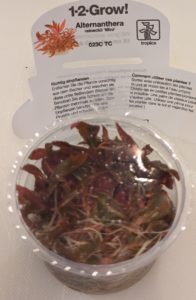
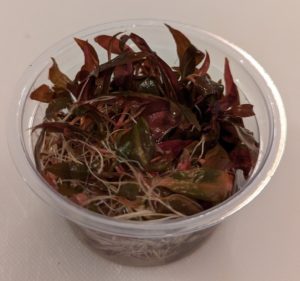

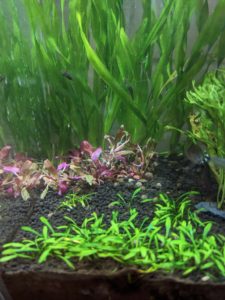
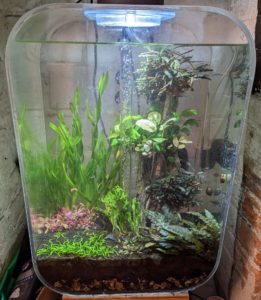

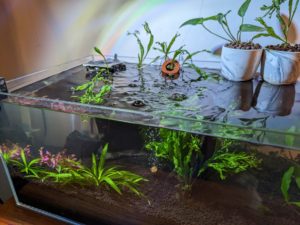

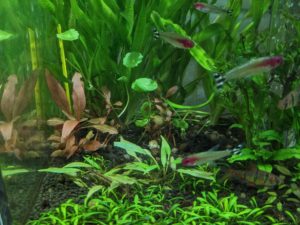
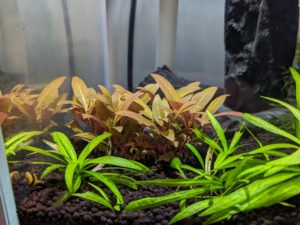
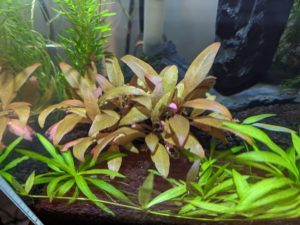
1 thought on “Planting Alternanthera reineckii ‘Mini’”